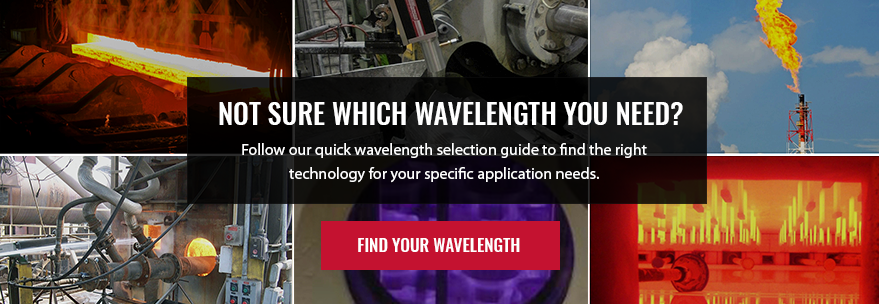Williamson Short-Wavelength Advantage
Infrared pyrometers rely on making a reading based on the amount of energy collected. The amount of energy collected can be affected by emissivity variance and optical obstructions. Selecting the shortest possible wavelength helps to eliminate variables such as emissivity variation and optical obstruction. Being less sensitive to these variables ensures for a more accurate reading compared to a general purpose long-wavelength sensor.
Emissivity Variance
Every object emits infrared energy proportional to its temperature. Infrared pyrometers collect the infrared energy emitted by an object and convert it into a temperature value. Emissivity is the percent of energy emitted by an object compared to the theoretical amount of infrared energy emitted by a perfect emitter at the same temperature. The amount of energy emitted is a function of both temperature and emissivity.
 Therefore, the emissivity of a measured target has a direct correlation to the energy reading of a pyrometer. Emissivity varies due to changes in material, surface texture, degree of oxidation, micro structure or surface contamination. The emissivity of a material can also vary at different wavelengths. The graph to the right shows that selecting the shortest possible wavelength will result in smaller errors due to emissivity variance. In fact, short-wavelength sensors can be 4-20 times less sensitive to emissivity variation compared to long-wavelength sensors. By reducing the errors caused by emissivity variation short wavelength sensors produce a more accurate and repeatable reading.
Therefore, the emissivity of a measured target has a direct correlation to the energy reading of a pyrometer. Emissivity varies due to changes in material, surface texture, degree of oxidation, micro structure or surface contamination. The emissivity of a material can also vary at different wavelengths. The graph to the right shows that selecting the shortest possible wavelength will result in smaller errors due to emissivity variance. In fact, short-wavelength sensors can be 4-20 times less sensitive to emissivity variation compared to long-wavelength sensors. By reducing the errors caused by emissivity variation short wavelength sensors produce a more accurate and repeatable reading.
Optical Obstructions
The other variables that alter the amount of energy collected by a sensor are the optical obstructions between the sensor and the measured target. Intervening optical obstructions such as steam, water, flames, plasma, dust, and smoke have the ability to affect the amount of energy measured by the sensor.

As an example, the above graph shows how water is an interference (opaque) across a wide range of the spectrum. A broad wavelength range would not be able to avoid this obstruction and would produce an inaccurate reading heavily affected by the presence of water. Selecting a narrow wavelength allows the pyrometer to avoid this interference. It is important to measure at a wavelength where the optical obstruction is transparent; otherwise, the interference will cause an inaccurate reading. The graph shows how selecting a narrow wavelength can avoid potential optical obstructions to ensure the measured value is the true temperature of the target itself. The long wavelength sensor will measure more of an average between the target and the obstruction producing an inaccurate reading.
Short vs. Long-Wavelength
The amount of energy collected by a sensor is influenced by the emissive characteristics of the target and the transmission characteristics of any intervening optical obstruction. The influence of these factors varies significantly at different infrared wavelengths. Selecting the shortest possible wavelength helps to eliminate the effect of these variables producing an accurate reading. When there are optical obstructions or variations in emissivity, a short-wavelength sensor is recommended to produce the most accurate and repeatable readings.
To learn more about Williamson short-wavelength sensors please click the below link to connect with an IR temperature expert.

